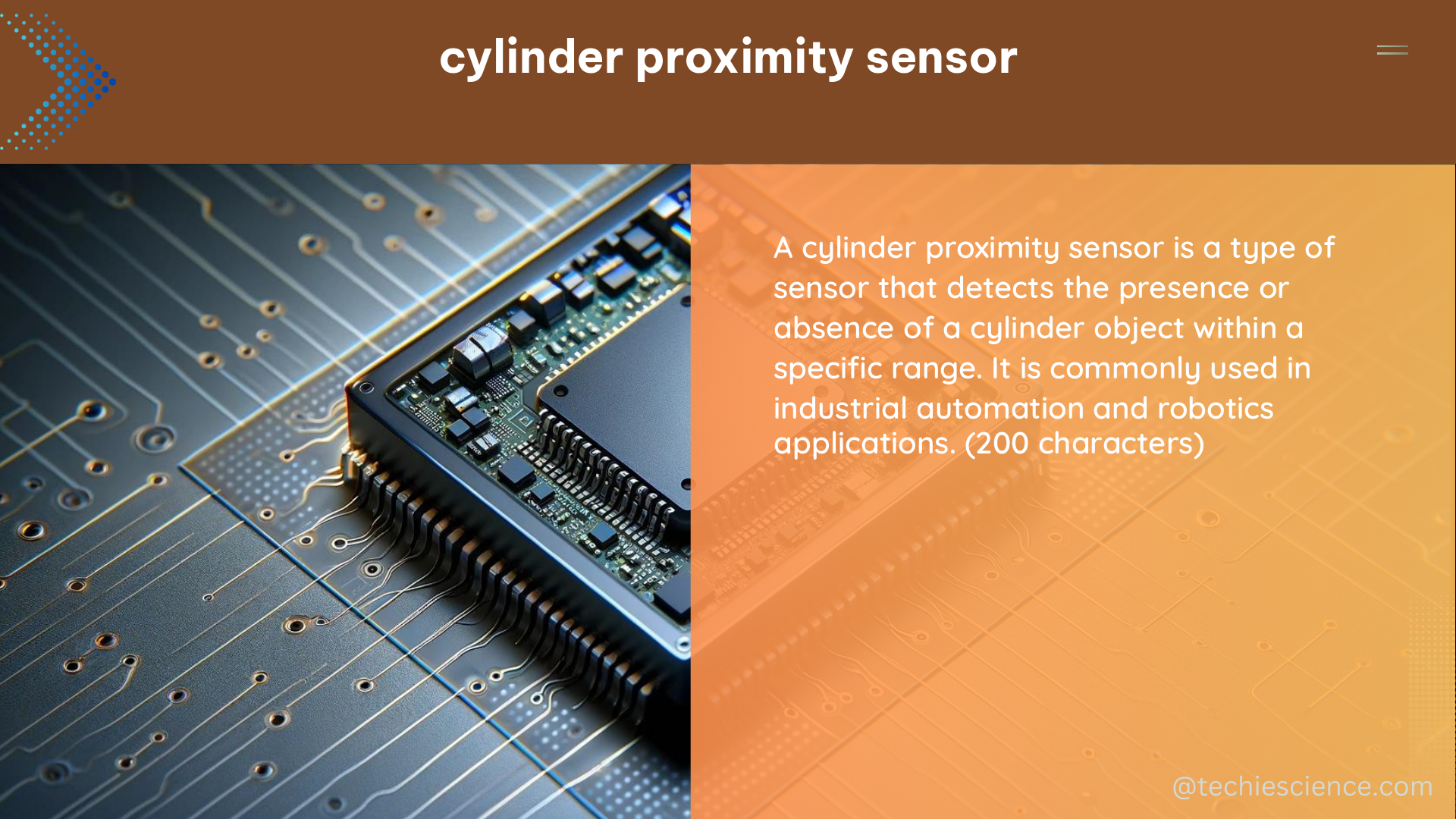Cylinder proximity sensors are essential components in various industrial and automation applications, providing precise position detection for pneumatic cylinders. These sensors come in different types, such as reed switches and solid-state sensors, each with its advantages and disadvantages. This comprehensive guide will delve into the technical details and best practices for working with cylinder proximity sensors.
Understanding Cylinder Proximity Sensors
Cylinder proximity sensors are designed to detect the position of a pneumatic cylinder’s piston. They can be classified into two main types:
-
Reed Switch Sensors: These sensors use a magnetically actuated reed switch that closes when a magnetic field is present, typically generated by a magnet attached to the cylinder’s piston. Reed switch sensors are known for their simplicity, reliability, and cost-effectiveness.
-
Solid-State Sensors: These sensors utilize solid-state technology, such as Hall-effect or magnetoresistive sensors, to detect the presence of a magnetic field. Solid-state sensors offer advantages like faster response times, higher durability, and the ability to provide analog output.
Factors to Consider when Selecting Cylinder Proximity Sensors

When choosing the right cylinder proximity sensor for your application, there are several key factors to consider:
1. Sensing Range and Resolution
- Sensing range: The maximum distance at which the sensor can reliably detect the presence of the cylinder’s piston. Typical sensing ranges for cylinder proximity sensors range from 2 mm to 50 mm.
- Resolution: The smallest detectable change in position. For high-precision applications, sensors with a resolution of 0.1 mm or less may be required.
2. Sensor Output and Compatibility
- Output type: Cylinder proximity sensors can have digital (e.g., NPN, PNP) or analog (e.g., 0-10 V, 4-20 mA) outputs, depending on the application requirements.
- Compatibility: Ensure the sensor’s output is compatible with the control system or PLC you are using.
3. Environmental Factors
- Temperature range: Sensors should be rated for the operating temperature range of the application, which can vary from -40°C to 80°C or higher.
- Ingress protection (IP) rating: The sensor’s IP rating indicates its level of protection against dust and water ingress, which is crucial for harsh industrial environments.
4. Mounting and Installation
- Sensor size and shape: Consider the available space and the cylinder’s design to ensure the sensor can be properly mounted.
- Mounting options: Cylinder proximity sensors may have different mounting configurations, such as threaded, flush, or side-mount.
5. Reliability and Durability
- Sensor lifetime: Evaluate the sensor’s expected lifetime, which can range from hundreds of thousands to millions of cycles, depending on the technology and application.
- Resistance to vibration and shock: Sensors should be able to withstand the vibrations and impacts common in industrial environments.
Practical Applications and Use Cases
Cylinder proximity sensors find applications in a wide range of industries, including:
- Pneumatic Automation: Monitoring the position of pneumatic cylinders in packaging, assembly, and material handling systems.
- Robotics: Detecting the position of robotic arms and end-effectors for precise control and coordination.
- Hydraulic Systems: Tracking the position of hydraulic cylinders in construction equipment, agricultural machinery, and industrial presses.
- Packaging and Labeling: Ensuring accurate positioning of products, packages, and labels during high-speed processing.
- Automotive Manufacturing: Monitoring the position of components in engine assembly, body assembly, and paint shop operations.
Sensor Integration and Troubleshooting
When integrating cylinder proximity sensors into your system, consider the following best practices:
- Power Supply and Voltage Levels: Ensure the sensor is powered within the recommended voltage range, and use a voltage divider circuit if necessary to protect the sensor and the connected control system.
- Sensor Placement and Alignment: Carefully position the sensor to ensure optimal detection of the cylinder’s piston, and maintain proper alignment to avoid false triggers or missed detections.
- Interference and Noise Mitigation: Shield the sensor and its wiring from electromagnetic interference (EMI) and radio frequency interference (RFI) to maintain reliable operation.
- Sensor Diagnostics and Monitoring: Implement regular sensor testing and monitoring to detect any degradation or failure, allowing for proactive maintenance and troubleshooting.
Emerging Trends and Future Developments
As technology continues to evolve, the field of cylinder proximity sensors is also experiencing advancements. Some emerging trends and future developments include:
- Wireless and IoT-enabled Sensors: The integration of wireless communication and Internet of Things (IoT) capabilities in cylinder proximity sensors, enabling remote monitoring and predictive maintenance.
- Intelligent Sensor Algorithms: The use of advanced algorithms, such as machine learning and artificial intelligence, to enhance sensor accuracy, adaptability, and fault detection.
- Integrated Sensor Packages: The integration of multiple sensing modalities (e.g., position, force, temperature) into a single compact sensor package for comprehensive monitoring and control.
- Miniaturization and Embedded Systems: The development of smaller, more compact cylinder proximity sensors that can be seamlessly integrated into compact and space-constrained applications.
By understanding the technical details, best practices, and emerging trends in cylinder proximity sensors, you can ensure reliable and efficient performance in your industrial and automation applications.
References:
- Collecting digital data from a PNP proximity sensor with Arduino – https://www.youtube.com/watch?v=7P_oq7R-Gaw
- Data Tabulation/Recording of Proximity Sensor using Arduino – https://forum.arduino.cc/t/data-tabulation-recording-of-proximity-sensor-using-arduino/578666
- Cylinder Position Sensors: Reed Type vs Solid State – Control.com – https://control.com/forums/threads/cylinder-position-sensors-reed-type-vs-solid-state.50316/
- Sensor Choices for Pneumatic Cylinder Positioning | Power & Motion – https://www.powermotiontech.com/technologies/cylinders-actuators/article/21885196/sensor-choices-for-pneumatic-cylinder-positioning
- Magnetic Field Sensors – Premature Failure – Mike Holt’s Forum – https://forums.mikeholt.com/threads/magnetic-field-sensors-premature-failure.148096/

The lambdageeks.com Core SME Team is a group of experienced subject matter experts from diverse scientific and technical fields including Physics, Chemistry, Technology,Electronics & Electrical Engineering, Automotive, Mechanical Engineering. Our team collaborates to create high-quality, well-researched articles on a wide range of science and technology topics for the lambdageeks.com website.
All Our Senior SME are having more than 7 Years of experience in the respective fields . They are either Working Industry Professionals or assocaited With different Universities. Refer Our Authors Page to get to know About our Core SMEs.